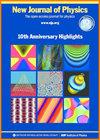Chirality-enabled topological phase transitions in parity-time symmetric systems
IF 2.8
2区 物理与天体物理
Q2 PHYSICS, MULTIDISCIPLINARY
引用次数: 0
Abstract
Photonic spin Hall effect (PSHE) in chiral PT-symmetric systems exhibits many exotic features, but the underlying physical mechanism has not been well elucidated. Here, through rigorous calculations based on full-wave theory, we reveal the physical mechanism of the exotic PSHE and identify a chirality-enabled topological phase transition. When circularly polarized light is incident on a chiral PT-symmetric system, the transmitted beam contains two components: a spin-flipped abnormal mode that acquires a geometric phase (exhibiting a vortex or a spin-Hall shift), and a spin-maintained normal mode that does not exhibit such a phase. If the phase difference between the cross-polarized Fresnel coefficients cannot be ignored, it results in a chirality-enabled phase and intensity distribution in the abnormal mode, which induces an exotic PSHE. Consequently, as the incident angle increases, a chirality-induced topological phase transition occurs, namely the transition from the vortex generation to the exotic PSHE. Finally, we confirm that the asymmetric and periodic PSHE in the chiral slab is also related to the phase difference between the cross-polarized Fresnel coefficients. These concepts and findings also provide an opportunity for unifying the phenomena of topological phase transitions in various spin-orbit photonic systems.奇偶时对称系统中的手性拓扑相变
手性 PT 对称体系中的光子自旋霍尔效应(PSHE)表现出许多奇特的特征,但其基本物理机制尚未得到很好的阐明。在此,我们通过基于全波理论的严格计算,揭示了奇异光子自旋霍尔效应的物理机制,并确定了一种手性拓扑相变。当圆偏振光入射到手性 PT 对称体系上时,传输的光束包含两个部分:一个是获得几何相位(表现出涡旋或自旋-霍尔位移)的自旋翻转异常模式,另一个是不表现出这种相位的自旋保持正常模式。如果不能忽略交叉偏振菲涅尔系数之间的相位差,就会导致异常模式中的手性相位和强度分布,从而诱发奇异的 PSHE。因此,随着入射角度的增大,会发生手性诱导的拓扑相变,即从涡旋生成过渡到奇异的 PSHE。最后,我们证实手性板中的非对称和周期性 PSHE 还与交叉偏振菲涅尔系数之间的相位差有关。这些概念和发现也为统一各种自旋轨道光子系统中的拓扑相变现象提供了机会。
本文章由计算机程序翻译,如有差异,请以英文原文为准。
求助全文
约1分钟内获得全文
求助全文
来源期刊

New Journal of Physics
物理-物理:综合
CiteScore
6.20
自引率
3.00%
发文量
504
审稿时长
3.1 months
期刊介绍:
New Journal of Physics publishes across the whole of physics, encompassing pure, applied, theoretical and experimental research, as well as interdisciplinary topics where physics forms the central theme. All content is permanently free to read and the journal is funded by an article publication charge.
 求助内容:
求助内容: 应助结果提醒方式:
应助结果提醒方式:


